Giochi dell'Oca e di percorso
(by Luigi Ciompi & Adrian Seville)
(by Luigi Ciompi & Adrian Seville)

|
Giochi dell'Oca e di percorso
(by Luigi Ciompi & Adrian Seville) |

|
 |

Torna alla ricerca giochi (back to game search) |
 |
| Willy's Walk to see Grandmamma | ||
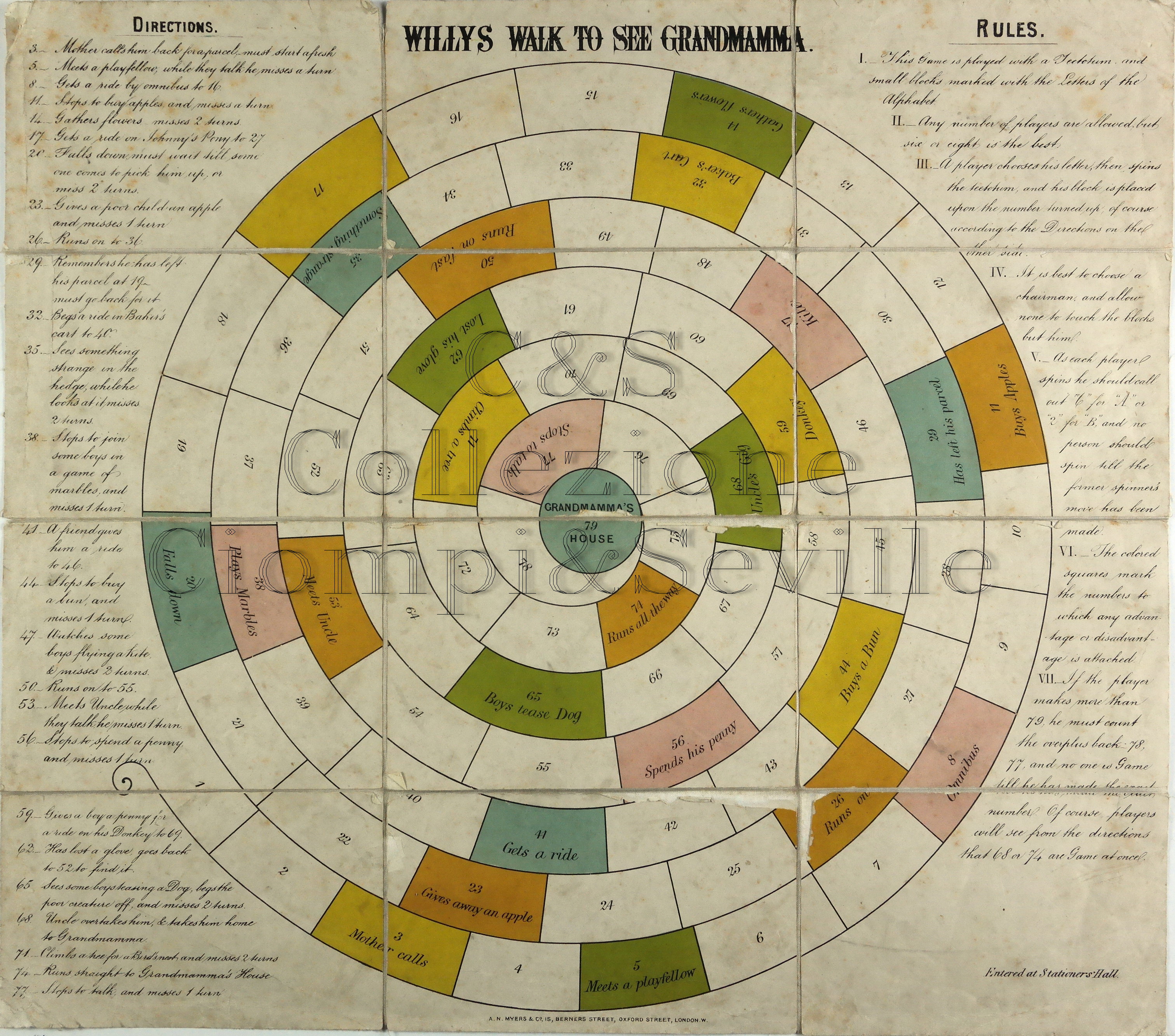 |
Versione stampabile
 |
Invia una segnalazione

|
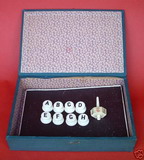    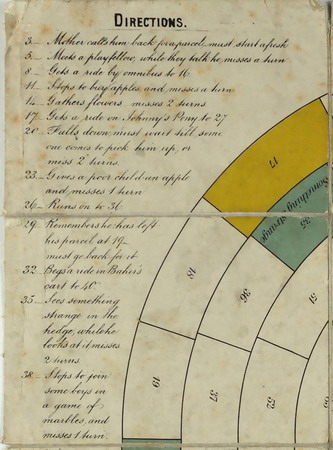 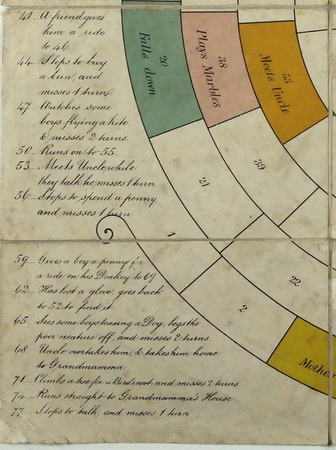 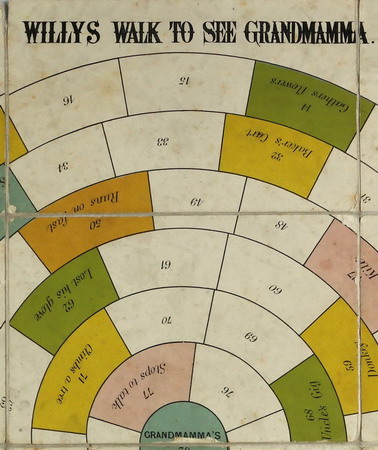 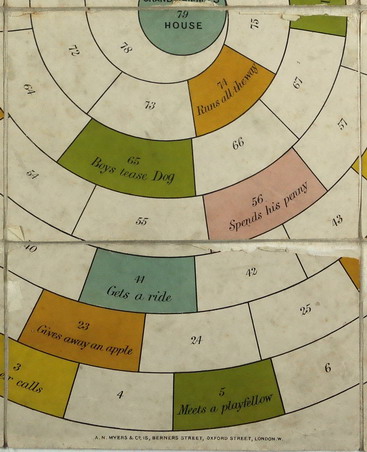 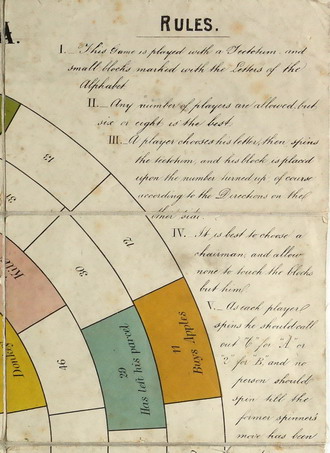 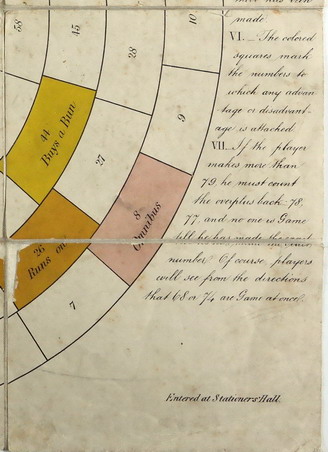 |
primo autore: | Non indicato |
| secondo autore: | Myers A. N. | |
| anno: | 1869 | |
| luogo: |
Inghilterra-Londra |
|
| periodo: | XIX secolo (3° /4) | |
| percorso: | Percorso di 79 caselle numerate | |
| materiale: | carta incollata su tela (engraving on paper with linen backing) | |
| dimensioni: | 509X584 | |
| stampa: | Litografia colorata a mano (hand-coloured engraving) | |
| luogo acquisto: | ||
| data acquisto: | ||
| dimensioni confezione: | 228X153X51 | |
| numero caselle: | 79 | |
| categoria: | Infanzia, educazione, pedagogia, favole e fiabe | |
| tipo di gioco: | Gioco di percorso | |
| editore: | A. N. Myers & C°, Berners Street, Oxford Street London W. | |
| stampatore: | Myers A. N. | |
| proprietario: | Collezione A. Seville | |
| autore delle foto: | A. Seville | |
| numero di catalogo: | 304 | |
| descrizione: |
Gioco di 79 caselle, spirale, antiorario, centripeto. La "Passeggiata di Willy per andare a trovare la nonna" è uno spensierato gioco per divertire i bambini. Si tratta di un percorso di 79 caselle che termina alla casa della nonna. Risale al 1869, mezzo secolo dopo esemplari più seriosi come quelli di Darton. Qui gli incidenti di percorso non sono intimidatori e le lezioni morali sono implicite piuttosto che apertamente dichiarate. Alcuni degli imprevisti sono simili a quelli del gioco dell'oca; per esempio alla casella 20 Willy cade e deve aspettare che qualcuno arrivi a tirarlo su oppure deve saltare due turni. Altre caselle indicano realisticamente tutte le distrazioni che possono far perdere tempo a un bambino lungo un tragitto: acquistare delle mele, raccogliere fiori, tornare a riprendere un pacchetto dimenticato, fermarsi a giocare con le biglie e così via. Ci sono anche modi in cui si può avanzare più rapidamente prendendo per esempio l'omnibus o chidendo un passaggio sul carro del fornaio. E' interessante notare che Willy è costretto a saltare un turno o due quando compie un'azione moralmente giusta quale donare una mela a un bambino bisognoso o persuadere altri bambini a non infastidire un cane. Un'opportunità quella di ricompensare un atto moralmente giusto con dei vantaggi, che non sarebbe certamente andata sprecata in giochi più antichi. REGOLE: ai lati del tavoliere. CASELLE: alcune con didascalia. REFERENZA 1 (Victoria and Albert Museum) This is not a very interesting or exciting example of a moral race game. There are no colourful illustrations. The rules are similar to other 19th century moral games. Some, however, seem to be the opposite of what one might expect. For example, forfeits are given for helping people or animals while rewards are given for accepting a lift on a cart. In other games, the forfeit would be paid for this as laziness and the reward, usually counters, for the help. In contrast to the normal six-sided teetotum or spinner, the playing pieces for this game are unusual. They are made of glazed earthenware marked with the letters A to H on the tops. Physical description Design: lithograph, coloured by hand; mounted on linen; spiral squares of which some are painted; not illustrated N°of squares: 79 Squares illustrated: none Square numbering: all Squares titled: some Subject of starting square: ? Subject of ending square: ? Place of Origin: London Date: 1869 Artist/maker: A N Myers & Co Materials and Techniques: Hand-coloured lithograph on linen Dimensions: Height: 50.9 cm; width: 58.4 cm. (Box): Height: 22.8 cm; width: 15.3 cm; depth: 5.1 cm Object history note: green cloth bound wooden box containing the game and parts; on the underside is an oval stamp of the retailer - ARTHUR F WATSON, THE MODEL BAZAAR, 45 ROBERTSON STREET, HASTINGS. *The rules are similar to all the moral games, however, some seem to be opposite for example forfeits are given for helping people or animals while rewards are given for accepting a lift on a cart. In other games, the forfeit would be paid for this as laziness and the reward, usually counters, for the help. Historical context note Rewards: forward movement, extra turns Forfeits: backward movement, lost turns N°of Players: 8 Equipment required: counters of glazed earthenware marked with the letters A to h on the tops teetotum of bone marked with red and black numbers 1 to 6 Rules: RULES: 1. This game is played with a teetotum and small blocks marked with letters of the alphabet. 2. Any number of players are allowed but six or eight is best. 3. A player chooses his letter, then spins the teetotum and his block is placed upon the number turned up, of course, according to the directions on the other side. 4. It is best to choose a chairman and allow none to touch the blocks but him. 5. As each player spins, he should call out '6' for 'A' or '2' for 'B' and no persons should spin till the former spinner's move has been made. 6. The coloured squares mark the numbers to which any advantage or disadvantage is attached. 7. If the player makes more than 79, he must count the over plus back - 78,77, and no one is Game till he has made the exact number. Of course, players will see from the directions that 68 or 74 are Game at once. DIRECTIONS 3. Mother calls him back for a parcel, must start afresh.. 5. Meets a playfellow, while they talk, he misses a turn. 8. Gets a ride by omnibus to 16. 11. Stops to buy apples and misses a turn. 14. Gathers flowers, miss two turns. 17. Get a ride on Johnny's pony to 27. 20. Falls down, must wait till some one comes to pick him up or miss two turns. 23. Give a poor child an apple and miss one turn. 26. Runs on to 36. 29. Remembers he has left his parcel at 19, must go back for it. 32. Begs a ride in Baker's cart to 40. 35. See something strange in the hedge, wile he looks at it, misses two turns. 38. Stops to join some boys in a game of marbles and misses one turn. 41. A friend gives him a ride to 46. 44. Stops to buy a bun and misses one turn. 47. Watches some boys flying a kite and misses three turns. 50. Runs on to 55. 53. Meets uncle, while they talk, he misses one turn. 56. Stops to spend a penny and misses one turn. 59. gives a boy a penny for a ride on his donkey to 69. 62. Has lost a glove, goes back to 52 to find it. 65. Sees some boys teasing a dog, begs the poor creature off and misses two turns. 68. Uncle overtakes him and takes him home to Grandmamma. 71. Climbs a tree for a bird's nest and misses two turns. 74. Runs straight to Grandmamma's house. 77. Stops to talk and misses a turn. Rules placement: on one side of the playing surface; additional rules on squares Descriptive line: Hand coloured moral race game, Willy's Walk to see Grandmamma, published in England by A. N. Myers in 1869. REFERENZA 2 "Consideré par certains comme étant le jeu le moins palpitant du genre jamais produit, dans lequel les pénalités et les récompenses sont donneées aussi bien quand on est bon que lorsqu'on est méchant, voici "Willy's Walk to See Grandmamma" (La promenade de Willy pou voir grand-maman) publié par A. N. Myers en 1869. C'est une lithographie peinte à la main sans illustrations. Il n'y pas de cagnotte et toutes les récompenses et punitions sont obtenues en avançant ou en passant des tours. Six cases se réfèrent au fait que Willy accepte des promenades, ce qui jusqu'ici était une mauvaise conduite mais valent de l'avancement dans ce jeu tandis qu'offrir une pomme à un pauvre enfant ou sauver un chien font manquer des tours." (GOODFELLOW Caroline) REFERENZA 3 "Considered by this author to be least exciting game of its type ever produced, in which penalties are given for being good as well as for being bad, is "Willy's Walk to See Grandmamma", published by A. N. Myers in 1869 as a hand-coloured lithograph. This spiral race game has no illustrations, and the rules and directions are written on the playing surface itself. There is no pool, and all rewards are made and forfeits paid by moving spaces or missing turns. Six compartments refer to Willy's accepting rides, hitherto regarded as a bad characteristic, but here they lead to advancement, while offering a poor child an apple or saving a dog from being teased leads to the penalty of missed turns." (GOODFELLOW Caroline) |
|
| bibliografia: |
1) GOODFELLOW, Caroline: "Jeux de société. Le guide du collectionneur des jeux de société depuis le XVIIIe siècle jusqu’à nos jours", (Edizione francese) Carrousel MS, 2001. 2) GOODFELLOW, Caroline: "A Collector's Guide to Games and Puzzles" Secaucus, New Jersey, Chartwell Books-London, Quintet Publishing Limited 1991. 3) LOVE, Brian: “Great Board Game”, Ebury Press 1979. 4) SEVILLE, Adrian: "L'arte dei giochi da tavolo. Oltre un secolo di storia e divertimento dalla fine del Settecento all'inizio del Novecento." Edizioni White Star, 2019. |
|
| "The Development of the English Board Game", 1770-1850 (Caroline G. Goodfellow) | ||
Vai alla ricerca giochi Vai all'elenco autori